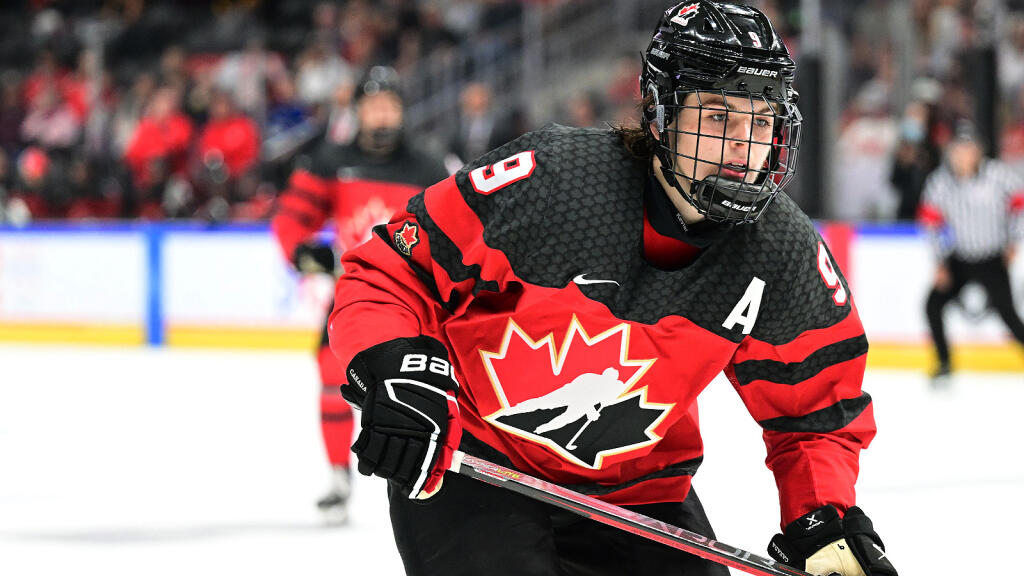Film Room: How Zach Benson stacks the deck in his favour

Zach Benson isn’t the fastest player or the biggest. He doesn’t have the best hands or the hardest shot.
Yet, despite physical limitations that suggest otherwise, the deck is always stacked in his favour.
With and without the puck, he dictates the game. And when all else fails, he will not be outworked.
At his core, Benson’s a manipulator, moving opponents around with rapid-fire deception. But he’s also so much more, with board skills the envy of top power forwards, stick work like a shutdown defender, and top-of-class anticipation.
Here’s how he does it.
High-pace deception
Deception is a delicate balance between patience and pace. Pass too soon, and the opposition won’t have reacted to the deception. Take too long, and defenders will apply pressure and eliminate threats. That’s true across every level, but none more than in the NHL.
Benson has struck that perfect balance between patience and pace. His touches are short but numerous. He deceives, waits for the reaction of the opponent(s), then advances the puck.
The first layer is more standard practice for top prospects: Benson takes an already open lane, fakes the shot just long enough to freeze the opposition, then passes to an open teammate. Most top prospects can take advantage of opponents’ poor decisions, but few consistently create those poor decisions.
With rapid-fire handling, full-body fakes, and look-offs, Benson carves through trickier defenders. He goes forehand-backhand, across the body, then back, beating the defender’s stick into the passing lane. He builds off these, using different handling patterns and speeds to baffle defenders.
He also exploits defenders’ desire to, well, do their job. Once he gets the puck, he knows a close-out is incoming. He invites it, pulling the defender towards him before passing through them. Many junior manipulators only make these plays along the board, starting wide, bringing the defender wide, and then passing through them. Benson does that regularly, but he also starts wide, attacks the inside, and passes back to the outside or straight through the defenders to a teammate driving the net just as often.
Notably, there aren’t many unnecessary movements in Benson’s game. It’s always just enough deception to open the lane, immediately followed by the next play. That’s patience and pace.
Inverting pressure
There’s one area of the rink where Benson’s even better than open ice: Along the boards. Yes, I know – it’s wild that a 5-foot-10, 159-pound winger is a beast along the boards. But it’s true. He’s the best off-the-boards playmaker in the draft since Rinkside’s founding. He does it by inverting pressure, taking a defender in front of him or to his side and getting them behind him, where they can't poke away the puck or overwhelm him physically.
The most common way NHLers invert pressure is by cutting back off the rush. They have a well-gapped defender in front of them, so they hit the brakes, then pass cross-ice. Simple enough.
That’s a Benson staple. He knows that he can’t outrace opponents, but he pretends anyway. Just as they build speed, he hits the brakes. With the defender behind him, he’s in control; he can cut inside, shoot, or most often, pass.
.png)
Again, that’s a play that most notable prospects should make, but that’s not the high point of Benson’s skill level; that’s the beginning.
He uses high-pace deception to get opponents on his back, even in tricky positions. He skates directly at opponents, fakes to freeze their feet, then pushes off into space. Done; the defender’s locked to his back. He turns to face the middle, waits for opponents to close the space, then wedges his body between them and the puck just as they reach. Another one stuck behind him. Then, it’s time to deceive and create.
And it’s these sequences where Benson’s incredible off-the-boards playmaking appears. Benson has all the other habits, too. He scans before touching the puck, waits for contact before cutting back, stick lifts opponents just as the puck comes through (more on that soon), and constantly gets inside positioning by skating through opponents’ hands.
Right play, right time, every time
Underpinning all of this – the high-pace deception, inverting pressure, and board play – is that Benson chooses the right play at the right time every time.
When he cuts back off the rush, he doesn’t immediately pass to the player driving the net. He finds the best option as soon as possible.
When he sets up behind the net, he doesn’t pass to the first option. He fakes one play, fakes another, and then passes to a better-positioned teammate just as they arrive in the slot.
Yet, it never feels like he’s hanging onto the puck too long. It’s always just the right amount of time, whether he’s making connecting with a one-touch backhand feed or a slip pass set up with rapid-fire deception to create the lane. And he doesn’t pass to where his teammates are; he passes where they are going or even where he wants them to go.
All these attributes remain under heavy pressure. Whether he’s pressed into the boards, falling, or fighting off several opponents, he chooses the right play, however much punishment that takes.
Right place, right time, every time
Another driving force in Benson’s game (there are many) is his off-puck positioning and awareness.
Benson’s always open. He reloads high in the offensive zone, building speed toward the net. He supports the cycle, rushes the net, battles for inside positioning, and pushes off at the right times – that’s how he gets most of his chances. He also provides short support off the rush, slipping behind his teammates to become a trailing option.
Many prospects understand how to get open and play the off-puck game, but few combine it so thoroughly with their on-puck game.
Benson uses the supporting game to rack up touches in prime areas. He scans before reception, then chooses the right ensuing play, often manipulating the defender before passing. The give-and-go is a staple, which he uses to bypass defenders, create passing lanes, and advance his team as a unit – manipulating opponents along the way.
Even if the puck isn’t coming, Benson knows that skating his routes to completion will bring defenders with him, creating more space for the next teammate joining the rush.
Stick work mastery
Benson is the best defensive forward in the draft; he’s arguably the best in the CHL. Few bring the level of off-puck intelligence, and none the level of stick work. Every game is a masterclass in puck recoveries, stick lifts, and poke checks. Being in the right place at the right time every time helps, but he also has a knack for timing.
Instead of leaning on opponents who aren’t an immediate option, Benson waits. Just as opponents are about to receive the puck, he gets under and lifts, jumps into the passing lane, or skates through their hands. When all else fails, he sprints all out. He matches footwork up top, eliminates threats down low, and swipes away the puck just as opponents lift their sticks off the ice. These are skills that many defencemen in this draft can’t match.
It’s the same story on retrievals. Benson stick-lifts opponents before touching the puck, even showing a bit of deception by lifting on one side, then beating them to the other. Then, he immediately creates high-value offence with the vision, high-pace deception, and patience he does everywhere else.
Together, all those skills make Benson the most well-rounded forward in the 2023 NHL Draft. He’s also arguably the best playmaker. That’s visible in my multi-year, 3000-forward tracking data set, where he set up the most expected goals per 60 since Connor McDavid. The gap between Benson and McDavid was smaller than the gap between Benson and third place. He also finished top-10 in three-zone steals per 60.
None of that would be possible without the interaction between Benson’s many skills. How the high-pace deception blends with the vision; how he maintains the deceptive act under heavy pressure along the boards; how he strings together different types of plays in rapid succession with his off-puck game; and so on.
And this article is just scratching the surface. He’s an incredible adapter. Eliminate one play? He finds five more. Take away his passing options? Now he’s manipulating opponents to dangle inside for scoring chances. Try to run him over? He slips through.
Even when things aren’t connecting, Benson still finds a way to impact the game. That bodes well for his NHL future.
The high-pace manipulation, board skills, play selection, off-puck instincts, defensive stick work, and adaptability – these are the skills of a top-line forward. Together, they could make him the type of player that drives an NHL top-line with top-end playmaking and Selke-level defence.
But even if he doesn’t get there, he will find a way to impact the game. He always does.


